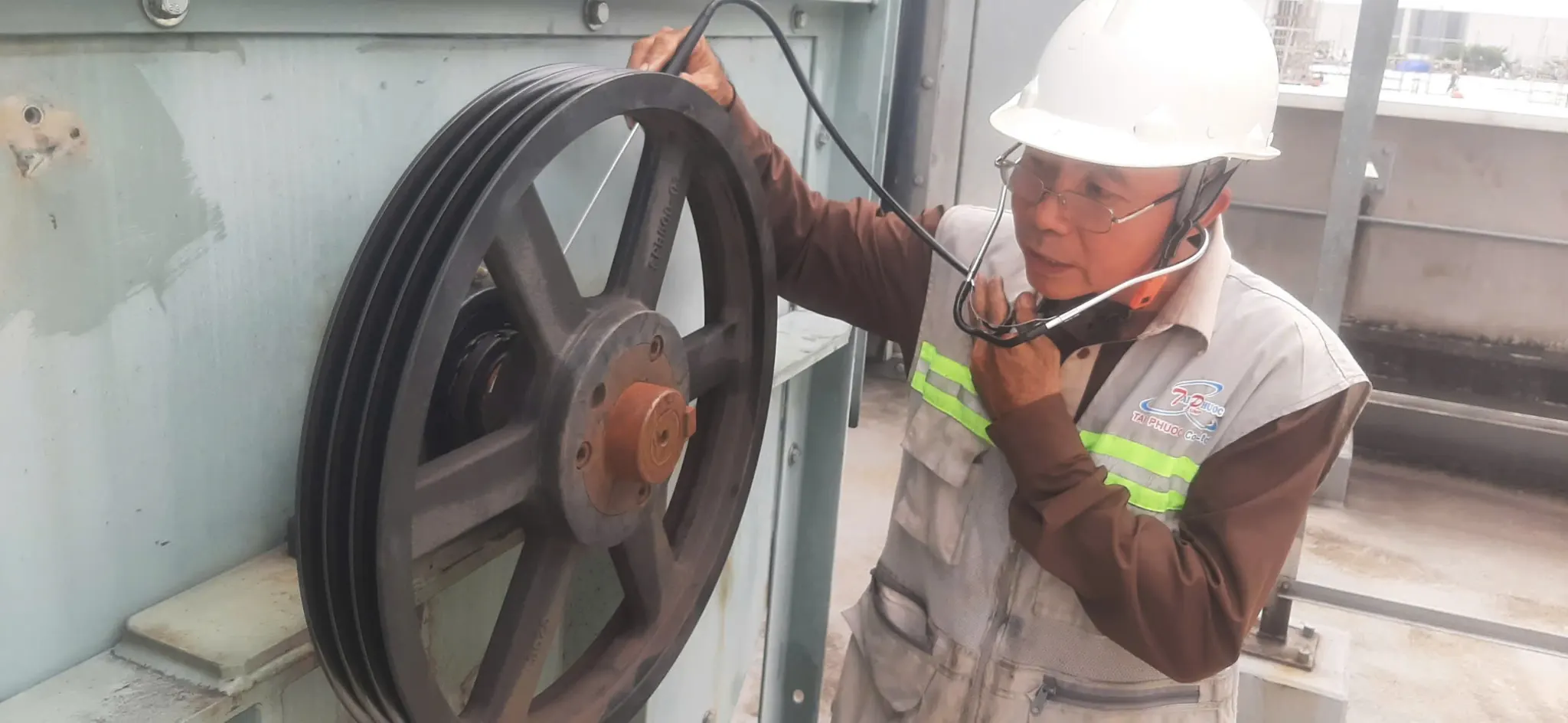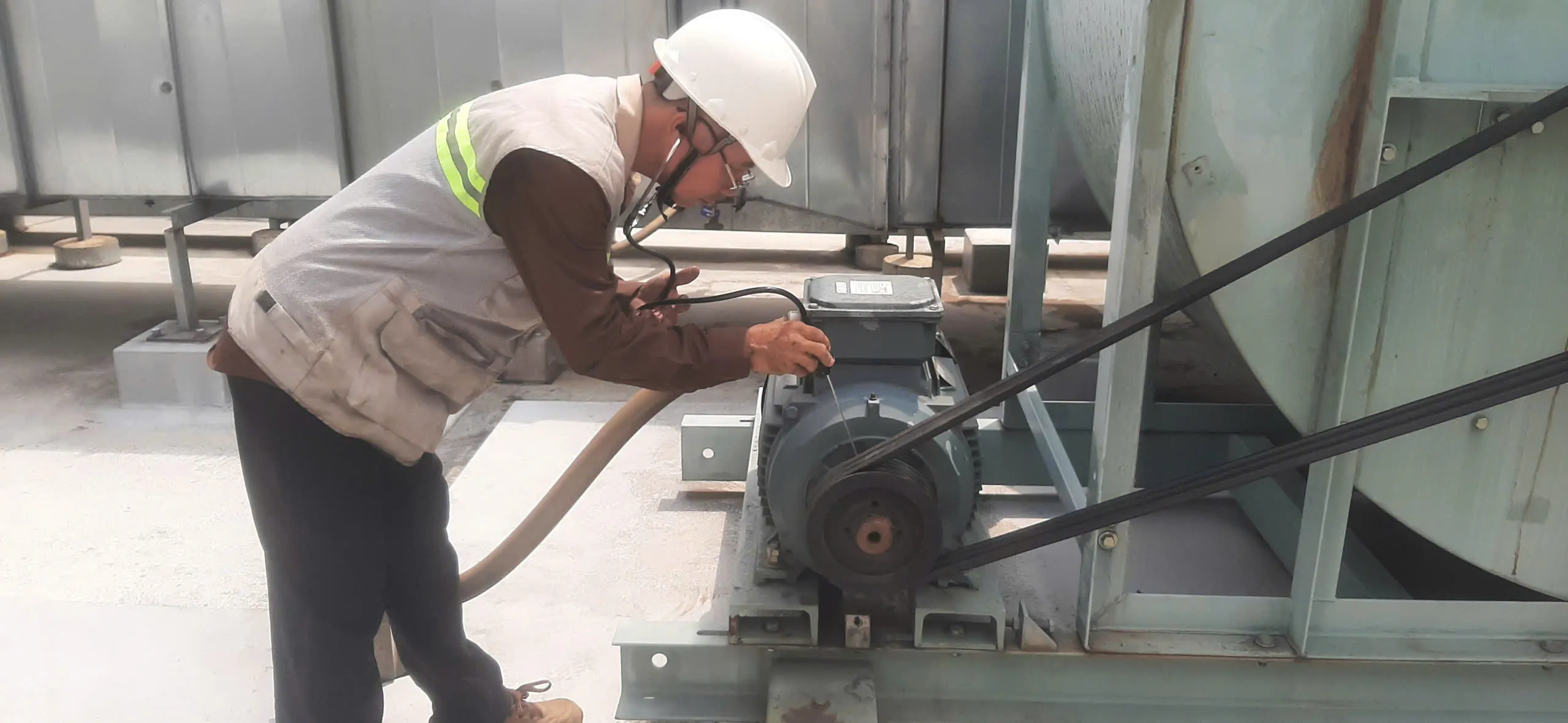DONG NAI — Customers at the Panasonic factory reported that the F-F-1-11-2 exhaust fan was making an unusual noise that increased with operating speed.
The engineering team of Tai Phuoc Trading-Service-Technology Co., Ltd. quickly arrived and began “on-site medical examination”
Using a mechanical stethoscope, the engineer “listened to the heart” of the drive pulley assembly to detect noises – similar to a doctor listening to a patient’s heartbeat.
The rustling sound signals worn bearings; A continuous screeching sound indicates misalignment or belt tensioning.
Initial preliminary diagnosis: shaft bearing failure (Q2), slight noise from the motor bearing (Q1), with signs of pulley-belt misalignment and blade dynamic imbalance.
 Engineer Tai Phuoc uses a mechanical stethoscope to check the noise of the exhaust fan pulley – a typical “diagnosis” operation of industrial machine doctors.
Engineer Tai Phuoc uses a mechanical stethoscope to check the noise of the exhaust fan pulley – a typical “diagnosis” operation of industrial machine doctors.
Checking the motor – Step of “detailed examination” of each bearing
Approaching the drive motor section, the engineer bends down to check the ball bearing (Q1) – an area that often vibrates and makes noise when the bearing is dry or the belt tension is incorrect.
 Engineer Tai Phuoc checks the motor bearing with a mechanical stethoscope – detects a small noise (Q1), an early sign of bearing wear.
Engineer Tai Phuoc checks the motor bearing with a mechanical stethoscope – detects a small noise (Q1), an early sign of bearing wear.
The motor in the system is a 3-phase induction motor 30 kW – 40 HP, speed 1470 rpm.
A slight noise in the pulley head bearing is an early warning signal, helping the engineering team accurately localize the area that needs to be handled.
Check the bearing housing – “Suspicious point Q2”
Inside the exhaust fan assembly, the engineer looked and listened at the Pillow Block Bearing – which was suspected to be the main cause of the noise.
 Engineer Tai Phuoc checks the fan shaft bearing bearing – the location of the abnormal noise of the F-F-1-11-2 fan.
Engineer Tai Phuoc checks the fan shaft bearing bearing – the location of the abnormal noise of the F-F-1-11-2 fan.
The black round cluster is the P2xx bearing, which contains the fan shaft bearing.
The yellow material at the shaft end is a temporary protective layer when the machine is stopped, helping to prevent dust from getting into the bearing.
This is where Q2 – the fan shaft bearing breaks/wears, causing vibration and potentially stopping the entire ventilation system if not handled in time.
The engineer is Look – listen – check the play/smoothness of the bearing, an important step to determine the damage (pitting, dry grease, misalignment…).
Close-up of the damaged detail – P216 / UK216 bearing
 Close-up of the P216 – UK216 bearing housing of the fan shaft, the location of the bearing hole is determined to cause noise and strong vibration.
Close-up of the P216 – UK216 bearing housing of the fan shaft, the location of the bearing hole is determined to cause noise and strong vibration.
This is a UK216 bearing mounted in a P216 housing, a standard heavy-duty type.
The outer surface of the bearing is black and dusty, showing signs of grease leakage and high temperatures – a common phenomenon when the bearing is pitted or misaligned, causing grease is squeezed out.
The dull color and the oily rim around the bearing edge indicate that the bearing has been operating for a long time without proper cleaning or re-lubrication.
The locking grooves and locating pins help to secure the shaft at high speeds. When the bearing breaks, pitting and dark burnt grease are typical signs of recognition.
Inside the “case” – When small eccentricity causes big consequences
The next two photos record the pulley – belt – fan shaft cluster, where concentric eccentricity is detected.
Close-up of the top pulley
 Close-up of the drive pulley assembly of the F-F-1-11-2 exhaust fan – wear and rust marks show the long-term eccentricity and vibration, the direct cause of bearing failure.
Close-up of the drive pulley assembly of the F-F-1-11-2 exhaust fan – wear and rust marks show the long-term eccentricity and vibration, the direct cause of bearing failure.
The image shows a triple-groove pulley connected to a drive belt from the motor.
Uneven wear on the belt groove and rust marks on the shaft collar are signs of misalignment and persistent vibration.
This is one of the main reasons why fan shaft bearings are overloaded and broken (Q2).
Puly side view Pump assembly and fan shaft bearing – small concentricity misalignment but big consequences: resonance vibration and bearing overheating.
Pump assembly and fan shaft bearing – small concentricity misalignment but big consequences: resonance vibration and bearing overheating.
We can clearly see the fan shaft attached to the P216 bearing, and the pulley disc is slightly displaced from the t lineshaft noise.
When the parallelism between the motor pulley and the fan pulley is out of alignment, the belt will wear out — creating resonant vibration and localized heat in the bearing.
“Just 1–2 mm of misalignment at the center of the pulley is enough to cause the bearing to deflect thousands of revolutions per minute,” says Tai Phuoc’s chief engineer share.
Technical Summary – Solutions and Practical Lessons
After completing the survey, the Tai Phuoc team proposed a 5-step troubleshooting process:
-
Replace shaft bearings are made of heat-resistant type ≥ 120 °C.
-
Check and replace the motor bearings synchronously if pitting or play is detected.
-
Align the pulley – belt concentrically with laser alignment.
-
Clean and dynamically balance the fan blades.
-
Test run, measure vibration – temperature – current, make acceptance report.
Expected result: noise reduction 30–50 %, restores air intake performance, extends bearing life and saves energy by reducing mechanical slip.
Image Meaning & brand
The above series of photos not only shows the technical process, but also clearly depicts the spirit “Pump Doctor” – the symbol of the Tai Phuoc engineering team:
“Diagnose by ear, verify by equipment, handle by experience.”
Each image is both technically educational and professionally inspiring – a testament to the working style “Responsible – Dedicated – Professional” that Tai Phuoc pursues.

